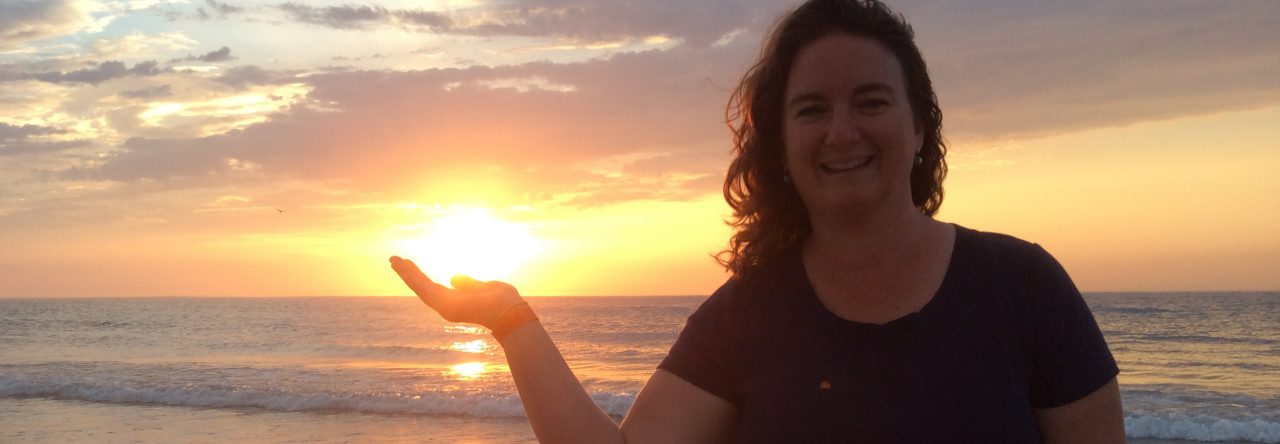Thanks for dropping my April’s Teaching Tree. I am April Zajko, M.Ed. and I am nature-inspired early childhood educator. Through my blog, writing, and professional development offerings I aim toward ‘growing a holistic view of childhood’.
Children need nature now more than ever ~ fresh air, freedom, movement, and play….all important parts of raising happy and healthy children. Please subscribe to my blog by putting your email address in the top right corner!
Follow along with April’s Teaching Tree on Facebook or Instagram for a daily photo and idea to for “Growing Outdoor Classrooms”!
Books are perfect way to inspire children and families to collect and play with natural materials. Loose parts are open ended play materials foster children’s creativity and imagination!
No book list is ever complete but here is a start. I’d love to hear about books that you like to read aloud to children to inspire playing with natural loose parts! I have tried to create categories…but near the top of the list is a new book I added this year to my book collection called “Anywhere Artist” and an old favorite “Hannah’s Collection”.
“In any environment, both the degree of inventiveness and creativity, and the possibility of discovery, are directly proportional to the number and kinds of variables in it.” ~Simon Nicholson
Collections:
Collections by Margaret Ballinger and Rachel Gosset
Hannah’s Collections by Marthe Jocelyn
Look What I Found! By Deborah Schecter (Level A Reader)
Small Treasures by Akimi Gibson
Snowballs by Lois Ehlert (collection of good snowman making things)
When This Box is Full by Patricia Lillie
Nature:
A Stick is an Excellent Thing: Poems Celebrating Outdoor Play by LeUyen Pham
Bees, Snails, & Peacock Tails by Betsy Franco & Steve Jenkins
Discovering Nature’s Alphabet by Krystina Castella and Brian Boyl
No One But You by Douglas Wood
One Little Balsam Fir: A Northwoods Counting Book by Lesley A. DuTemple
Stranger in the Woods by Carl R. Sams II
Rocks:
A Rock is Lively by Dianna Hutts Aston
Everybody Needs a Rock by Byrd Baylor
If Rocks Could Sing: A Discovered Alphabet
If You Find a Rock by Peggy Christian
Let’s Go Rock Collecting by Roma Gans
Stone Soup by Jess Stockham
Rocks: Hard, Soft, Smooth, Rough
On My Beach There are Many Pebbles
Elizabeti’s Doll
Rocks, Fossils, & Arrowheads (Take Along Guides) by Laura Evert
Roxaboxen by Alice McLerran
Sticks, & Bark:
The Alphabet Tree by Leo Lionni
Not a Stick by Antoinette Portis
Stick Man by Julia Donaldson
Stick and Stone by Beth Ferry and Tom Lichtenheld
Trees, Leaves, & Bark (Take Along Guides) by Diane Burns
Clay:
When Clay Sings by Byrd Baylor
Clay Boy by Mirra Ginsburg
Leaves:
Leaf Jumpers by Carole Gerber
Leaf Man – Lois Ehlert
Leaves by Violet Findley
Leaves on the Trees by Thom Wiley
Leaves! Leaves! Leaves! By M & G. Berger
Look What I Did with a Leaf! By Morteza E. Sohi
Make a Leaf Rubbing by M. Ballinger,Gosset
The Leaves are Falling One by One by Metzger
We’re Going on a Leaf Hunt by S. Metzger
When the Leaf Blew In by Steve Metzger
Why Do Leaves Change Color? By Betsy Maestro
Acorns & Squirrels
Acorns Everywhere! by Kevin Sherry
Busy Squirrels by Melvin and Gilda Berger
Chipmunk at Hollow Tree Lane by Victoria Sherrow
Earl the Squirrel by Dan Freeman
Just One! by Sam McBratney
Nuts to You! by Lois Ehlert
Scaredy Squirrel by Melanie Watt
Squirrels by Brian Wildsmith
The Busy Little Squirrel by Nancy Tafuri (board book)
The Secret Life of Squirrels by Nancy Rose
Those Darn Squirrels! by Adam Rubin
Pinecones:
Evergreens are Green by Susan Canizares
The Pinecone Walk by Barbara Springfield
Night Tree by Eve Bunting
Shells:
What Lives in a Shell? By Kathleen Weidner Zoehfelf
Seashells, Crabs, and Sea Stars (Take Along Guide) by C.K.Tibbitts
Seashells by the Seashore by Marianne Berkes


 A card making station is a great way to inspire open-ended exploration and creativity while encouraging fine motor development, as well as early reading and writing skills. Prior to introducing the children to the station, gather up materials that you have on hand and set it up all in one place that can be left for several days (or weeks). Aim to make the materials all items that the children can use independently, so they can create on their own without much adult help. If you leave the card making station set up over time, occasionally swing by when not in use to tidy up and add one or two new tools or materials to keep the area inviting and sparking new ideas. As you add new supplies, take some of the other items away. Make sure that the area doesn’t become cluttered or children will feel overwhelmed by the choices and may find it harder to create.
A card making station is a great way to inspire open-ended exploration and creativity while encouraging fine motor development, as well as early reading and writing skills. Prior to introducing the children to the station, gather up materials that you have on hand and set it up all in one place that can be left for several days (or weeks). Aim to make the materials all items that the children can use independently, so they can create on their own without much adult help. If you leave the card making station set up over time, occasionally swing by when not in use to tidy up and add one or two new tools or materials to keep the area inviting and sparking new ideas. As you add new supplies, take some of the other items away. Make sure that the area doesn’t become cluttered or children will feel overwhelmed by the choices and may find it harder to create.